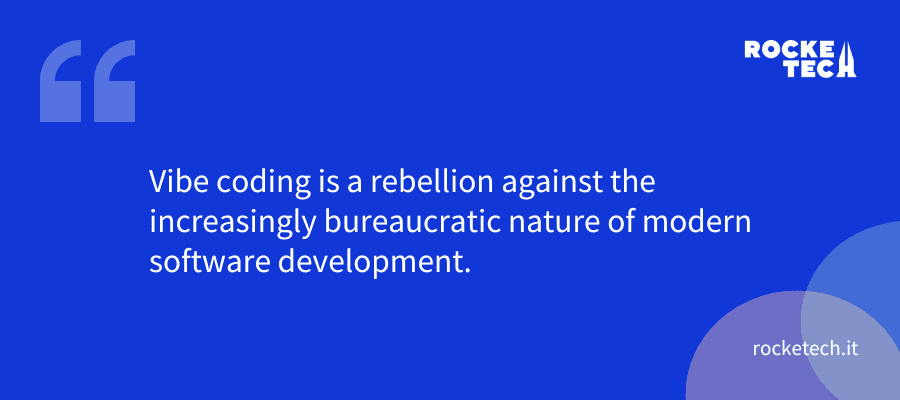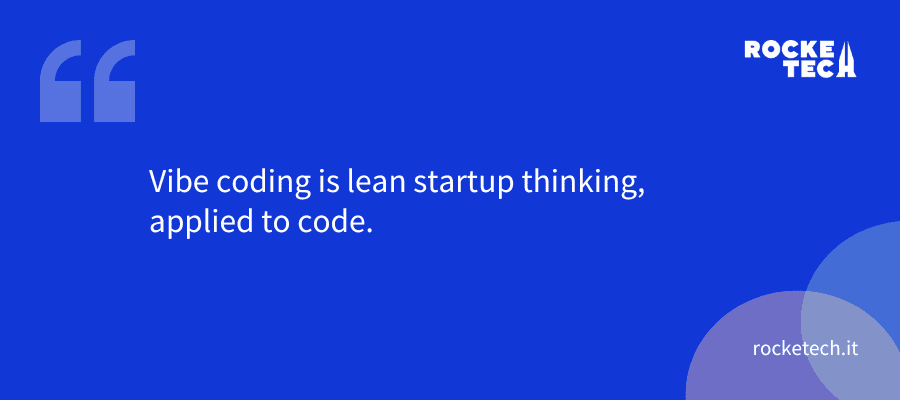Imagine building your app like you write a tweet: no spec, just vibes. You open your laptop, crack your knuckles, and start coding with nothing but a rough idea bouncing around in your head. No wireframes, no technical documentation, no sprint planning meetings. In simple terms, this is vibe coding.
Vibe coding is the art of building software by instinct and rapid iteration — fast, fluid, and free from rigid planning. It may sound reckless, but it’s quietly fueling some of tech’s most innovative products. For businesses willing to embrace a bit of chaos, it could be the edge they’ve been chasing.

Where It Came From
Vibe coding didn’t emerge in a vacuum — it’s the natural evolution of several converging trends in the tech world. The rise of powerful AI-assisted tools has made it possible for developers to translate fuzzy ideas into working code faster than ever before.
| Platforms like Replit have democratized coding by removing traditional barriers, while the solo hacker culture has celebrated the art of building first and documenting later. |
The movement gained momentum during the pandemic when remote work forced developers to be more autonomous and self-directed. Without constant oversight and formal processes, many discovered they could ship features faster by trusting their instincts rather than waiting for approval on detailed specs.
Simultaneously, the explosion of no-code and low-code tools showed that valuable products could be built quickly without traditional software engineering rigor.
But perhaps most importantly, vibe coding represents a rebellion against the increasingly bureaucratic nature of modern software development. Big companies pile on processes — sprint planning, story points, tech debt reviews — while small teams are rediscovering the joy of just building things that work.

What Vibe Coding Looks Like in Reality
Picture Sarah, a product manager at a mid-sized SaaS company. On a Tuesday afternoon, she has an idea for a simple internal tool that could help the sales team track leads more efficiently. Instead of writing a detailed spec, scheduling stakeholder meetings, and waiting three months for the development queue to clear, she opens up Cursor IDE and starts building.
She begins with a basic form — just name, email, and company fields. No database design document, no API specification. She codes the frontend first, making design decisions based on what “feels right.”
When she needs a backend, she prompts Claude to help her set up a simple Express server. Within two hours, she has a working prototype that three sales reps are already testing on real leads.
| This is vibe coding in action. Sarah doesn’t know if the tool will scale to 10,000 leads, and she hasn’t considered edge cases like duplicate detection. But she’s solved an immediate problem with minimal overhead, and now she has real user feedback to guide the next iteration. |
Or consider the hackathon scenario. Teams have 48 hours to build something compelling, and there’s no time for traditional planning. The winning projects rarely follow best practices — they’re held together with API calls to services that shouldn’t work together, databases designed on the fly, and user interfaces that break half the time.
But they solve real problems in creative ways, often leading to full products or inspiring features in existing ones.
AI-powered development tools have become the secret weapon of vibe coders. GitHub Copilot can autocomplete entire functions based on a comment describing the intended behavior. ChatGPT can generate boilerplate code, suggest architectural patterns, or debug cryptic error messages.
| Beyond speeding up coding, these tools help developers stay focused, even with unfamiliar technologies or complex problems. |
The result is a development style that prioritizes momentum over methodology, where the question isn’t “Is this the right way to build it?” but rather “Does it work for what we need right now?”
Why Vibe Coding Works for Business
To understand this, we need to look at vibe coding not as just a developer’s playground but a tool that gives businesses a serious edge, especially when speed matters.
Speed to Market
Startups live or die by how fast they move. Spending months on specs and architecture reviews can mean missing the moment. Vibe coding flips the script — build first, refine later.
Take a fintech startup, for example. Their users were struggling with expense reports. Instead of launching a full-blown requirements analysis, the CTO spent a weekend hacking together a basic expense scanner using phone camera APIs and OCR.
Within days, users were uploading receipts and categorizing expenses. By the time competitors finished planning, they had a working product and real user data.
Lower Cost of Experimentation
Traditional development is expensive before it even begins: planning, design, architecture, and so on. Vibe coding lets businesses place small bets instead of going all-in on one big plan.
It’s lean startup thinking, applied to code. Build a rough prototype in hours. If it flops, no big loss. If it clicks, you’ve already got the foundation for something bigger.

Creative Freedom Drives Innovation
When developers aren’t boxed in by rigid specs, magic happens. They explore, experiment, and sometimes stumble onto elegant solutions no one saw coming. That freedom can be a powerful innovation engine.
The Risks of Vibe Coding
Naturally, it’s not all sunshine and shipping velocity. Vibe coding has its pitfalls and darker sides that business leaders should be aware of and consider before starting this journey.
Technical Debt Builds Fast
Code written quickly, without documentation or consistent patterns, can become a nightmare to maintain. As teams grow or requirements shift, that early freedom can turn into long-term pain.
Integration Can Get Messy
Imagine that different parts of the system are built with different assumptions. That’s a recipe for integration headaches. Without shared architecture, things can break in unexpected ways.
Fragile Codebases
Vibe-coded apps often work great… until they don’t. Edge cases, unexpected inputs, scaling issues — these can cause major failures, especially in customer-facing products where reliability is non-negotiable.
When Vibe Coding Makes Strategic Sense (and Where It Doesn’t)
Vibe coding isn’t a universal solution, but when used in the right context, it can unlock serious advantages. The key is knowing when speed and flexibility outweigh the need for structure and long-term planning.
Where Vibe Coding Excels
Here are four real-life examples where vibe coding can become a game-changer.
- MVP Development
When the goal is to validate a product concept, you don’t need a polished system but answers. Vibe coding helps teams test core hypotheses fast and iterate based on real user feedback, not theoretical assumptions.
- Internal Tools
Internal projects often have clear goals, forgiving users, and lower reliability demands. A quick dashboard for the marketing team doesn’t need enterprise-grade architecture; it just needs to solve the problem.
- Early-Stage Product Exploration
Before committing serious resources, vibe coding lets businesses test assumptions about user behavior, technical feasibility, and market demand. With modern deployment tools, sharing prototypes with real users is fast and frictionless.
- Competitive Startup Environments
In fast-moving markets, speed is everything. Vibe coding helps startups ship features quickly and stay ahead. Yes, it may create technical debt, but with growth and funding, that can be cleaned up later.
Where Vibe Coding Falls Short
For all its strengths, vibe coding isn’t built for every situation. In some cases, the risks outweigh the benefits.
- Regulated Industries
Sectors like healthcare, finance, and aerospace demand documentation, testing, and compliance. Vibe coding skips those steps, which makes it a non-starter in these environments.
- Foundational Systems
If you’re building infrastructure that will support your business long-term, you need architectural planning and documentation. Vibe coding’s short-term focus doesn’t provide the stability or scalability required.
- Mission-Critical Applications
Systems where downtime has serious consequences need reliability above all. Vibe coding’s unpredictability makes it risky for anything that can’t afford to fail.
- Large, Complex Teams
Vibe coding works best when context is shared easily, which gets harder as team size grows. Large teams need formal specs and structured coordination to stay aligned. Without that, things break down fast.

Is Vibe Coding Good or Bad?
Vibe coding is like jazz: messy, intuitive, unpredictable, and brilliant when the moment calls for it. It’s not here to replace traditional software engineering. It’s here to complement it, offering a faster, more fluid way to explore ideas when speed and creativity matter more than structure and certainty.
In fast-moving markets, vibe coding gives teams an edge. While competitors are still drafting specs, vibe coders are shipping prototypes, gathering feedback, and iterating in real time. It’s a way for small teams to punch above their weight and for organizations to place many small bets instead of one big one.
But it’s not a free pass to skip planning forever. The real power lies in knowing when to switch gears, using vibe coding to explore, then layering in structure as products mature. The future belongs to teams that can blend both worlds: rapid experimentation up front, solid engineering as things scale.
So is vibe coding good or bad? It’s neither. It’s a tool. And like any tool, its value depends on how and when you use it. In a world where the cost of trying new ideas keeps dropping, the ability to build on vibes might just be the next big competitive advantage.
Let’s find out together. Get a free consultation.